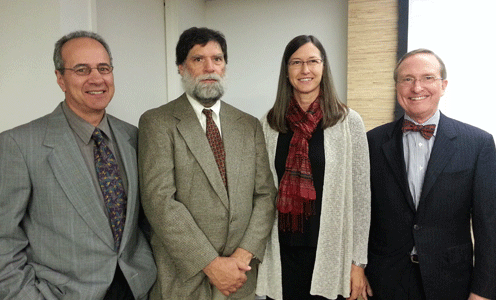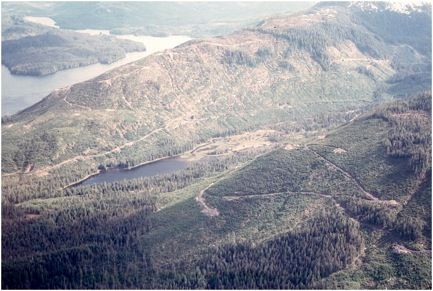Sharon is busy with schoolwork this week and has asked me to pinch-hit on the Botkin book discussion blog (my choices are Kat Anderson or Hugh Raup for book #2). PLEASE make all comments at the book blog location once this has been posted here by using the link in the upper right hand corner under the book icon. If you haven’t visited the site yet, the best place to start — and to introduce yourself — is: http://virtualbookclubforestpolicy.wordpress.com/2013/09/10/virtual-book-club-moon-and-the-nautilus-shell-i-introductions/
The focus of this chapter is the disparity between computerized model predictions of wildlife populations over time, their actual populations, and why these numbers are usually so different from one another. This is an important distinction because most of our fish and game management objectives are based on the former, inaccurate, “balance of nature” computerized numbers, as are many of our Endangered Species population estimates. Botkin also provides a brief parallel history of ecology as a science, which concludes with one of my favorite quotes in the whole book:
“Many believe that ecology is still a “young” science, but in comparison to most modern sciences, it is not young but simply retarded.”
This chapter examines the truth to that statement by comparing elephants in Africa, anchovies in Peru, salmon in the Pacific Northwest (where I had the pleasure of working under Botkin and participating in the first of his studies of that animal), and whales in the ocean, with fruit flies in a jar. Botkin’s examples and thoughts are clearly presented and described in well written English, with little use of Latin, metrics, or acronyms; i.e., “Plain English.” As a result, almost anyone with a basic education and good reasoning skills can follow his logic, arguments and conclusions.
The chapter opens with the story of one of the world’s first protected wildlife populations, the elephants of Tsavo; a large 5,000-square mile national park in Kenya, Africa dedicated to the survival of African big game animals. The park was created in 1948, 65 years ago, largely through the efforts of a single man, David Sheldrick, for the protection of declining African elephant and rhinoceros populations from their principal predators: human ivory and meat hunters. The primary purpose for protecting these animals was to attract tourists to the park in order to view them. Within 10 years the elephant herd had increased to 36,000 animals and the landscape had become largely denuded of vegetation. By the mid-1960s it was decided that 3,000 of the animals needed to be shot, in order to preserve the habitat. This idea was overturned and the decision was made to “let nature take her course” and allow the elephants and vegetation to achieve a “naturally balanced” “carrying capacity.” A prolonged drought in 1969-1970 contributed to the destruction of most of the remaining vegetation and an estimated 6,000 elephants starved to death.
Botkin uses this story to illustrate the difference between a theoretical balance of nature, and a balance created by people; i.e., roughly the difference between shooting 3,000 elephants and letting 6,000 elephants starve to death. A third alternative is also considered – that Tsavo was simply too small to contain that many animals and that they needed to migrate from one area to another during times of drought or other stressors. Following Sheldrick’s death in 1977, poachers again entered the preserve and by the 1980s the herd had been reduced to 6,000 animals. Today it stands at about 12,000 – far less than the 36,000 that had once lived there under Sheldrick’s management practices.
The elephants of Tsavo are used as a beginning point to examine other human attempts to manage the environment to achieve a desired number of animals. The wildly fluctuating populations of Peruvian anchovies, Pacific sardines, Atlantic menhadens, and several other commercial fisheries are provided as examples where harvest levels were established in attempts to stabilize populations, and failed; typically resulting in abrupt declines in the targeted species. These failed attempts at controlling natural populations of desired fisheries were based on scientific models. This is an important consideration because much of the world’s food supply – particularly in poorer countries – is provided by fish.
This is the principal theme of Chapter 2: the consistent failure of scientific predictive models to accurately estimate wild animal populations, and the reason that Botkin concludes ecology is “retarded” when compared to other modern sciences. He begins in 1838 with Pierre-Francois Verhulst’s simulation of natural populations with the invention of the S-shaped logistic growth curve, which results in a conceptual “carrying capacity” for the environment. Laboratory experiments in the 20th century replicated this model with certain insects and with bacteria, thereby seeming to prove its utility for wild fish and elephants. Alfred Lotka, an early mathematical ecologist, used fruit flies, bananas, and aquariums to fine-tune this equation, and was able to maintain stable populations of these animals in controlled environments. This artificially regulated number of insects was termed a “density-dependent” population, Lotka’s equation was named the “logistic” model, and Botkin cites a paper written in 2010 that examines this potential phenomenon in regards to wild elephants.
As Botkin next explains that, although the logistic equation is considered an “ecological formula,” its mechanical basis can be compared to “a collection of identical colliding balls” with “a certain rate of destruction” and “capable of identical rates of division.” In using this equation to consider a herd of elephants there is no differentiation between bulls, calves, or breeding cows, for example, just a total number, as with the box of identical balls. This idealized balance of population numbers cannot (“has never been observed to”) occur in nature, of course, and Botkin describes the logistic equation as “something from [Lotka’s] imagination, not from actual observation” – as occurred with the world fisheries or the Tsavo elephants.
Following the widespread adoption of Lotka’s work in the field of ecology, Botkin goes on to describe how it has evolved into a simple calculation that is exactly ½ as large as predicted carrying capacity: the “maximum-sustained-yield” population. To complicate the picture further is the fact that it is impossible to accurately measure many wild populations in the first place – Botkin uses Arctic crabs and the television show Deadliest Catch as his example, and comes to the conclusion that the maximum-sustained-yield concept is “fundamentally flawed.”
The Marine Mammal Act of 1972 tried to overcome this broken model with a new concept: “the optimum sustainable population,” and Botkin was hired to help develop this idea. His approach was overturned, however, and a panel of University of Washington scientists recommended a return to the failed logistic model and reinstituted the ideas of “maximum productivity” and “carrying capacity.” This led to Botkin’s conclusion that the scientists had reverted to a belief in the disproved myth of the “balance of nature,” and subsequently led to his book Discordant Harmonies, and ultimately to this present work:
“Thus even today, in both law and in practice, the scientific conservation of endangered marine species continues to be based on the idea that nature undisturbed is constant and stable . . .”
In other words, the management of endangered whales is based on computerized mathematical formulas developed with fruit flies in an aquarium, and not on actual observations by people:
“An irony is that it seems that everybody talks about how complex nature is . . . but we are content to formalize nature in about as simple and simplistic a way as possible.”
2 Questions:
Botkin argues that it is important that people – and particularly scientists – must accept the contradictions between fact (“observations”) and theory (“computer models”). Agree or disagree?
He further argues that this acceptance will lead to a “deeper level of thought” and allow us to find a “true harmony of nature.” Does that even sound plausible or necessary?



